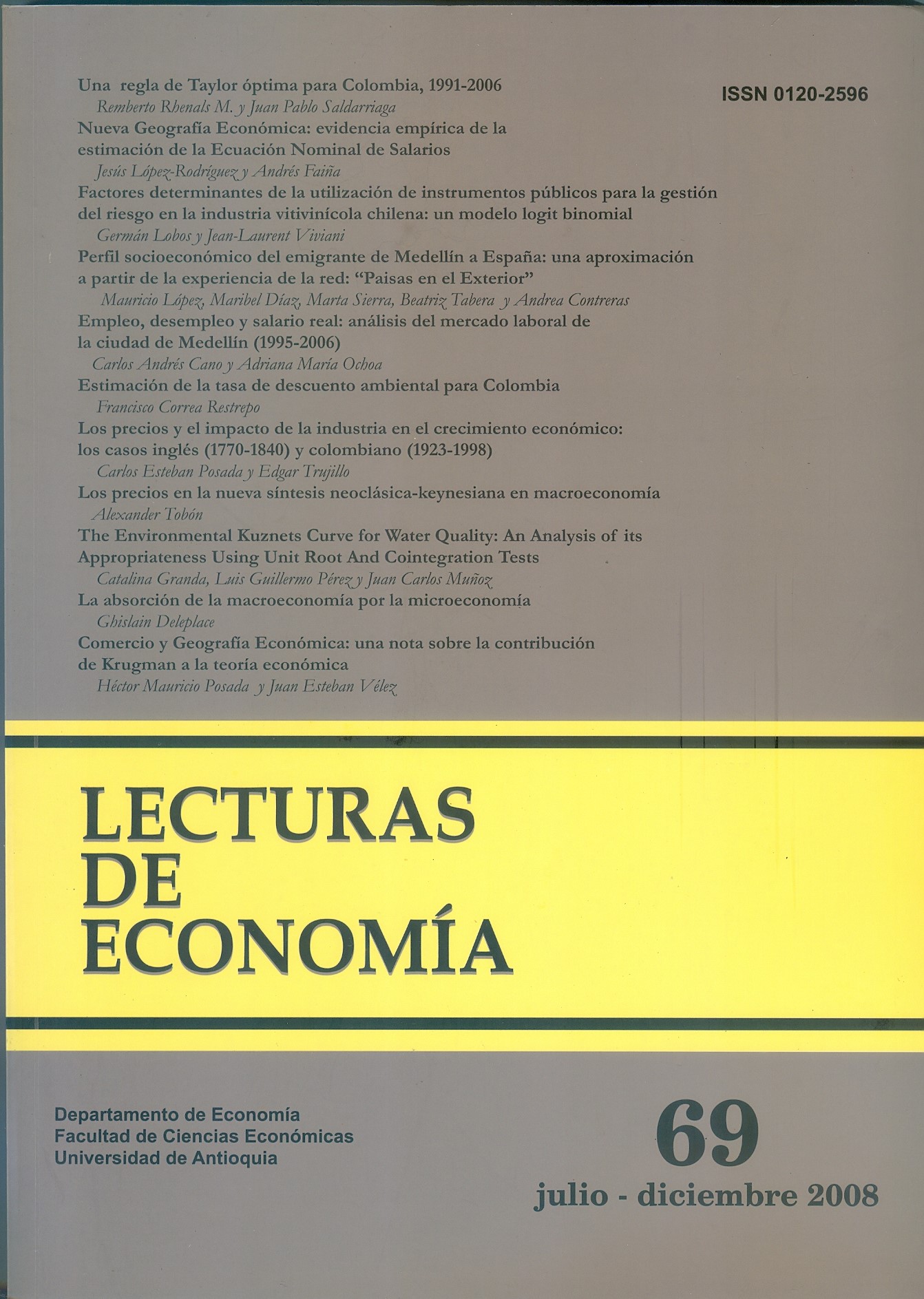Una regla de Taylor óptima para Colombia, 1997-2006
DOI:
https://doi.org/10.17533/udea.le.n69a731Abstract
En este artículo se estima una regla monetaria óptima de una economía abierta para Colombia en el período 1991-2006, mediante el Método Generalizado de los Momentos (GMM). Los resultados muestran que, en el primer período (1991-1999), las autoridades monetarias tuvieron un objetivo de inflación y otro de tipo de cambio; mientras que en el segundo período (2000-2006), el tipo de cambio no parece ser objeto de preocupaciones para las autoridades o, por lo menos, no utilizaron la tasa de interés para este objetivo. La brecha del producto es estadísticamente significativa en ambos sub-períodos, pero la magnitud de su coeficiente es prácticamente despreciable.
Palabras claves: Reglas, discrecionalidad, función de reacción de la política monetaria, regla de Taylor óptima, tasa de inflación, tasa de interés. Clasificación JEL: E43, E52, E58
Abstract:
In this article, an open-economy optimal monetary rule is estimated for Colombia over the period 1991-2006 using the Generalized Method of Moments (GMM). The results show that in 1991-1999 the monetary authorities had two targets: one for the inflation rate and another for the exchange rate. In contrast, the exchange rate did not seem to be a concern for the monetary authorities during 2000-2006, or at least they did not use the interest rate to address such a goal. The output gap is statistically significant in both sub-periods, but the magnitude of its coefficient is practically negligible.
Keywords: Rules, Discretion, Monetary Policy Reaction Function, Optimal Taylor Rule, Inflation Rate, Interest Rate. JEL Classification: E43, E52, E58
Résumé :
Cet article présente une estimation d.une règle monétaire optimale dans le cadre d'une économie ouverte appliquée à l.économie colombienne pour la période comprise entre 1991 et 2006, en utilisant la Méthode des Moments Généralisée (GMM). Les résultats montrent que, pour la première période (1991-1999), les autorités monétaires ont eu à la fois un objectif d'inflation et un objectif de taux de change; tandis que pour la seconde période (2000-2006), le taux de change ne semble pas être l'objet de préoccupations de la part des autorités monétaires, au moins, ils n'ont pas utilisé le taux d'intérêt pour atteint cet objectif. L'écart du produit est statistiquement significatif pour les deux périodes choisies, mais l'ampleur de son coefficient est pratiquement négligeable.
Mots Clef: Règles, caractère discrétionnaire, fonction de réaction de la politique monétaire, règle de Taylor optimale, taux d'inflation, taux d'intérêt. Classification JEL: E43, E52, E58
Downloads
Published
How to Cite
Issue
Section
License
This page, by Universidad de Antioquia, is licensed under a Creative Commons Attribution License.
Authors who publish with this journal agree to retain copyright and grant the journal right of first publication, with the article licensed under a Creative Commons Attribution-NonCommercial-ShareAlike License allowing others to share it as long as they acknowledge its authorship and original publication in this journal.
Authors can enter into separate, additional contractual arrangements for the non-exclusive distribution of the journal's published version of the work (e.g., post it to an institutional repository or publish it in a book), provided that these arrangements be not for profit and the journal be acknowledged as the original source of publication.
Authors are permitted and encouraged to post their papers online (e.g., in institutional repositories or on their websites), as it can lead to valuable exchanges as well as greater citation of the published work.







